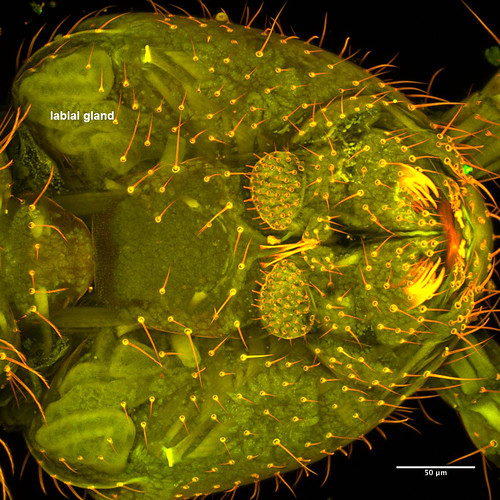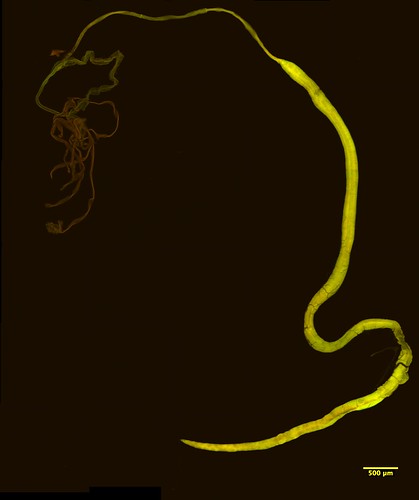This post is the final in a short blog series called “Know your Insect”. The images and descriptions are written by Entomology graduate students enrolled in a seminar of the same name.
By: Yuhao Huang
What are insect salivary glands?
Insect salivary glands are several exocrine glands that are associated with insect oral cavity and produce secretions (typically saliva) mixed with food during ingestion. There are basically four types of glands— hypopharyngeal glands, maxillary glands, mandibular glands, labial glands—which can be called salivary glands in insects. But generally these glands do not all occur at the same time in an insect.
Hypopharyngeal glands
For hypopharyngeal glands, they normally occur in Hymenoptera, like honey bees. In addition to the salivary enzymes they produce, these glands also yield secretions to feed the larvae.

Maxillary glands
For maxillary glands, they are often found in some non-insect hexapods, like Protura and Collembola, and in some larval Neuroptera and Hymenoptera. These glands are involved in the lubrication of mouthparts (Francois et al. 1986).

Mandibular glands
For the mandibular glands, they can be found in many Hymenoptera and Lepidoptera larvae. In some hymenopterans, mandibular glands excrete alarm pheromones while in some Lepidoptera larvae they function as part of predigestion system and chemical recognition of plants and microorganisms (Maria et al. 2012).

Labial glands
For the last one—labial glands, they are almost present in all insects, except in Coleoptera. Their structure differs among diverse orders and in some Lepidoptera larvae, they are called silk glands. Generally, they are the main functional salivary glands because they produce most of the saliva for insects.

Saliva
Normally, the main products of salivary glands are saliva which have been demonstrated having diverse roles. For example, it has been found that larval Helicoverpa zea saliva’s protein—glucose oxidase—can suppress tobacco plant Nicotiana tabacum’s induced defenses—the production of nicotine (Musser et al. 2012). In blood-feeding insects like mosquitoes, one of the critical functions of the saliva they produced is to prevent blood clotting (Ribeiro et al. 2003).
My research
One of my research projects is to probe the effect of secretions of insect herbivores’ labial glands on plant’s induced defenses. Most of the study about how herbivore’s saliva affect plant-induced defenses concentrate on the labial glands.

However, the roles of mandibular glands on plant defenses has been largely neglected, including their accessory glands, like Lyonet’s gland. So the exploration their functions will facilitate our understanding of how insect herbivore digesting food and countering host plant defenses.

So many hardwork collecting this data & So Good work? Keep it up??
This thing accept to u
The “labial gland” depicted in Figure 3 for a dipluran in fact is not a salivary gland but the labial kidney. Homologues to the labial salivary glands in insects also occur in diplurans, but they are not visualized in this image. Labial kidneys and their common orifice with the labial salivary glands are primarily maintained in insects, such as bristletails and silverfish, but they are invariably absent in winged insects (Pterygota).
Do we know the speed of insect salivary secretion. such as sphid and mosquito?